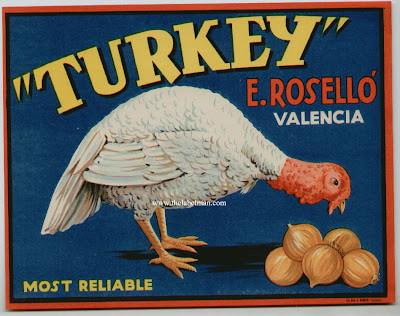Until the introduction of
inexpensive corrugated cardboard boxes in the 1960s, growers and distributors
of vegetables and fruits shipped their produce in wooden crates. The practice
began in the 1870s soon after the completion of the transcontinental railroad and the development of refrigerated boxcars.
For the first time, produce grown in farmlands and groves became widely
available to consumers hundreds or even thousands of miles away.
 The packing boxes
initially were imprinted to indicate the contents, company name and
place of origin. Most markets and grocery stores displayed produce in the same
wooden crates in which it was shipped, so growers and distributors realized that fancier labeling was a great way to differentiate their produce from their competitors' and catch the shopper's eye. By the 1920s, fully colored
lithographed labels—emblazoned with striking images such as tropical flowers,
boats, historical figures and bathing beauties—became common. But the most
common theme was the produce itself: apples from Washington and Oregon, oranges
from California, vegetables from Texas, sweet potatoes and yams from Louisiana, citrus from Florida. The labels were printed on high-quality paper and glued onto the ends of the boxes.
The packing boxes
initially were imprinted to indicate the contents, company name and
place of origin. Most markets and grocery stores displayed produce in the same
wooden crates in which it was shipped, so growers and distributors realized that fancier labeling was a great way to differentiate their produce from their competitors' and catch the shopper's eye. By the 1920s, fully colored
lithographed labels—emblazoned with striking images such as tropical flowers,
boats, historical figures and bathing beauties—became common. But the most
common theme was the produce itself: apples from Washington and Oregon, oranges
from California, vegetables from Texas, sweet potatoes and yams from Louisiana, citrus from Florida. The labels were printed on high-quality paper and glued onto the ends of the boxes.
Little is known about the
artists who created these enticing images. Many were German immigrants who came
to New York and Chicago and learned commercial art skills at trade schools,
according to Collectors Weekly. They would then head to large printing houses
like Schmidt Litho in San Francisco or Western Lithograph in Los Angeles. A
large company might employ 100 artists, all of whom worked anonymously.
The widespread use of
crate labels came to a halt by the 1960s when growers and distributors replaced
the heavier wooden crates with corrugated cardboard boxes, which were cheaper,
lighter and easier to store.
Some of these unused labels
languished for decades in warehouses, printers’ files and farmers’ barns. They
now are a market for collectors. Prices are determined by age, rarity, graphic
appeal and subject matter. The price for a rare, high-quality, well-designed
label could reach $30 to $40. The more common labels, such as those discovered
in bulk, sell for $2 to $15. Collectors Weekly offers some guidance on prices
and designs.















No comments:
Post a Comment